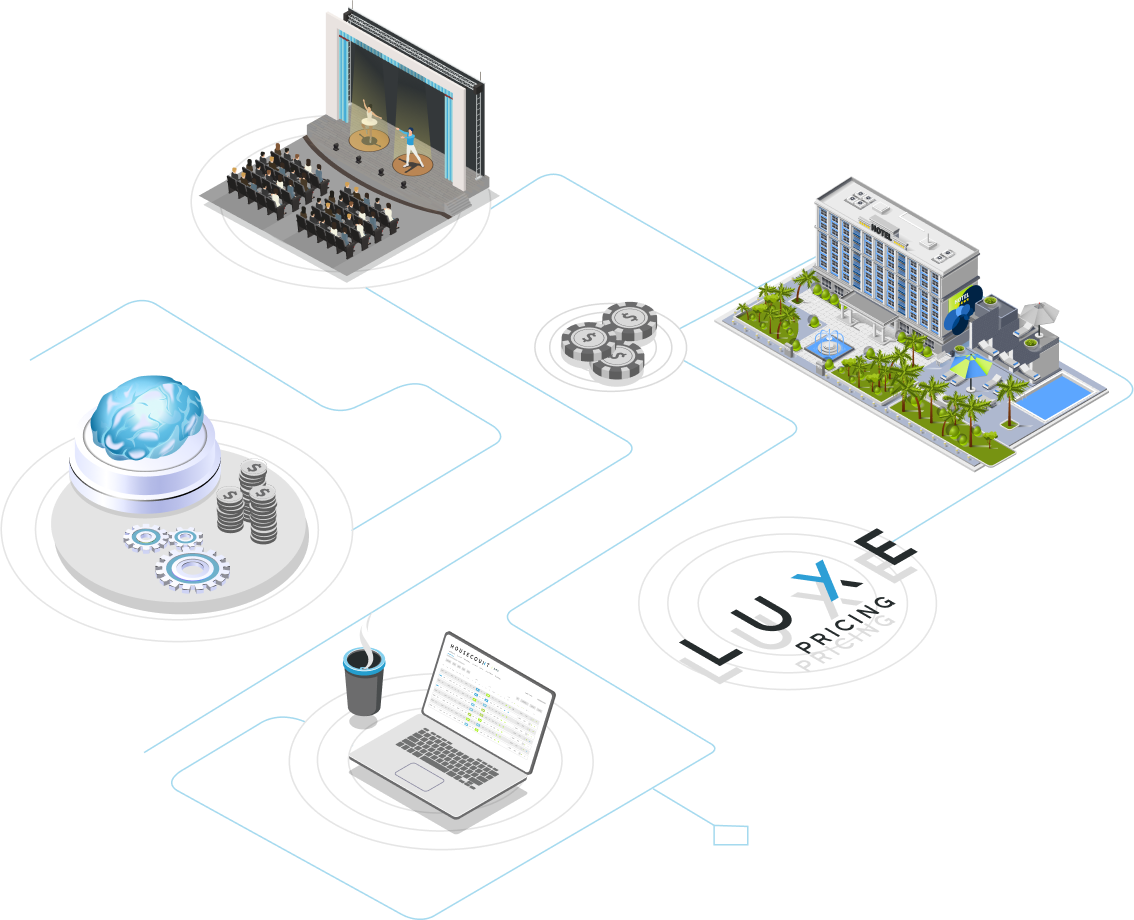Hotel Revenue Management Strategies: Boost Daily Profit Now
Effective hotel revenue management is perhaps more important to hospital businesses today than ever before. Running a...
Table of Contents
Hotel yield management is a pricing strategy utilized by businesses in the hospitality sector to maximize profits and revenue. This strategy involves adjusting prices for services or rooms based on availability, demand, and other factors to optimize profits from each guest.
Techniques based on supply and demand form the foundation of hotel yield management. For example, hotels increase pricing in high-demand periods or lower prices during the off-season.
Implementing hotel yield management strategies requires hotels to understand the demand and supply dynamics of their local and broader target market. This means tracking and analyzing pricing trends and customer demands to make informed decisions regarding price adjustments.
This "What Is Yield Management" article covers what hotel yield management involves, shows examples of how yield management can help hotels grow their business, and demonstrates how our yield management software, HouseCount RMS, can automate the process.
Hotel yield management uses demand estimation and forecasting techniques to determine whether booking channels should be rejected or accepted and whether room rates should be lowered or raised to maximize profits.
Car rentals, hotel rooms, and airline tickets are highly perishable items of the hospitality industry that, if not sold on a specific day, can lose the potential income they could have generated.
Hospitality establishments see the value of closing quality deals with more revenue generated per unit of inventory rather than aiming for a higher booking volume or a higher rate alone. Thus, the goal is high-profit reservations and high-profit rooms.
There are several strategies that hotels can use to implement yield management effectively, including:
Effective hotel yield management can help companies increase revenue and profits by filling rooms and other facilities at the highest possible rates. To implement these strategies effectively, hotels must use various tools, such as revenue management software, data analytics platforms, and reservation systems.
Luxe Pricing's HouseCount RMS and Luxsell URS connect seamlessly with your business's existing tech stack and offer real-time pricing updates plus upselling opportunities, even if you have multiple properties.
HouseCount RMS helps hoteliers accomplish two primary goals: provide accurate price recommendations for hotel and casino-hotel properties through an intuitive user interface that offers insight into maximizing revenue. The system utilizes demand, inventory, and historic pricing data to make real-time price recommendations that are updated as conditions change. HouseCount RMS uses feedback control theory and machine learning to provide accurate, flexible, and transparent price recommendations.
A 360-degree campus view allows you to manage all prices across all properties while providing additional features, such as price suggestions based on booking velocity and position, inventory type yielding, and casino yielding. HouseCount RMS is fully focused on user experience and pricing accuracy, making it one of the top RMS solutions on the market.
Hotels must strike a balance between maximizing revenue and providing a positive customer experience, as overpricing or under-delivering services can lead to customer dissatisfaction and negative reviews.
From upsell opportunities to accurate price management, Luxe Pricing is here to maximize your revenue.

Hotel yield management is a revenue management strategy that aims to optimize the revenue generated by hotel properties. Dynamic room rates based on supply, demand, availability, and other elements help boost revenue.
There are multiple reasons why hotel yield management is essential:
Hotel yield management also involves identifying and targeting the most profitable customer segments, such as leisure or business travelers, and creating personalized marketing strategies to appeal to these audiences.
HouseCount RMS was developed to help manage hotel revenue sources autonomously. AI and machine learning are used to determine room prices based on velocity, position, booking volume, price segment, and more to give hoteliers the most accurate recommendations possible.
The hotel industry is highly competitive, and one of the primary challenges for hoteliers and managers is maximizing their rooms' yield. There are multiple methods of measuring yield in the hotel industry, and each of them provide different insights into the performance of the establishment and its ability to generate revenue.
Here are some of the most commonly utilized methods:
Besides these traditional methods, there are more advanced ways hotels measure yield. These strategies require a cohesion of software, including a central reservation system, property management software, and revenue management system.
Let's dive into each of these to learn more about them.
Room rates play a critical role in boosting profits. Hotel pricing strategies are the perfect tools to determine customer touch points while increasing occupancy, receiving valuable booking data, and improving customer satisfaction.
Here are key factors to consider when trying to develop a suitable hotel room pricing strategy:
Upsell Opportunities
Beginning with upsell opportunities, hoteliers can use software like Luxsell URS to determine potential upgrades for guests that are arriving to the hotel or for guests that have just booked. Once the hotel agent enters information into Luxsell’s dashboard, the system provides the employee with an offer to maximize upsell revenue. Micro experimentation and A-B testing form the foundation of Luxsell URS, meaning the software gets smarter as it offers more recommendations improving the chances of closing more deals.
Services Offered
Thinking beyond room sales is key to finding additional revenue opportunities. Hoteliers must consider their on-site amenities and what they’re selling them for. Offering services or products, such as gaming areas, breakfast buffets, spa packages, and discount vouchers for local businesses, can help hotels accomplish their revenue goals.
Property Size
It’s also vital to monitor a hotel's performance over time. Performance insights give hoteliers the information they need to develop an efficient pricing strategy. HouseCount RMS was built to manage single or multiple properties, even if running on different property management systems. It provides a complete view that shows the demand for all properties, allowing users to manage pricing for their whole portfolio from a single page.
Level of Competition in the Area
Hotels are in constant competition both against comparable hotels, other entertainment alternatives, and themselves. While revenue managers aim to grow revenue year after year, competing hotels in the area may have a material impact on a hotel’s demand and pricing power. In these scenarios, hotels are still strongly advised to monitor their own demand levels rather than trying to follow competitor prices. As we often say, your own demand is the strongest indicator of your own demand! This involves focusing on key indicators such as position, velocity, and group business. Hotels can gather this information in HouseCount RMS’s work terminal to quickly interpret and take action on pricing.
Target Market
Understanding the requirements of your target market is key to developing a successful hotel pricing strategy. A hotel’s target market is the particular portion of all hotel customers a hotel tries to get business from. This could be families on vacation looking for resorts in Orlando or business travelers for a hotel near a conference center or airport.
Property Location
Finally, property location will determine several things, including profitability, customers, sales volumes, and long-term survival in the industry. Considering where the property is located and what businesses surround it can help revenue managers tailor deals that may appeal to the local target market. Surrounding airports, recreational grounds, and commercial areas should be considered when developing your hotel pricing strategy.
Understanding the market's needs is the first step to creating a successful hotel pricing strategy.
HouseCount RMS aids in pricing strategies, as any price changes across channels can be automated.
The system drives public and private pricing channels, allowing hotel owners or managers to set room rates and distribute them across the hotel's network.
There is no one size fits all hotel pricing strategy.
However, when the correct combination of software is included in your strategy, the potential of accurately measuring yield is increased.
From upsell opportunities to accurate price management, Luxe Pricing is here to maximize your revenue.

Hotel price monitoring relates to the ongoing monitoring and measurement of demand elasticity, often called pricing power. Several factors may affect a hotels pricing power, including:
When implementing an effective hotel price monitoring strategy, it is vital to have a system for collecting and analyzing room prices and demand data. A platform like Luxe Pricing’s HouseCount RMS is critical to gathering and monitoring these essential statistics. The more price changes that have been implemented, the better the system gets at providing accurate pricing recommendations.
Additionally, sales are recorded in HouseCount RMS’s dashboard, allowing the revenue manager or owner to check performance after the last rate change. The velocity column has an actual and target that allows you to click on and view all previous booking activity on a specific room.
HouseCount RMS is good at working with small numbers and can accurately price inventory by room type, price level, or segment. Depending on client preference, the software can aggregate prices into larger inventory categories for more dynamic yielding.
When establishments are connected to multiple online travel agencies and distribution channels, hotel pricing compliance often contractually stipulates their price. The hotel's prices through these channels must match the rates offered on its website and other mediums and should be at least the minimum rate agreed to with the third-party vendor. This is called rate parity.
Failure to adhere to these pricing regulations can result in the following:
HouseCount RMS helps hotels, theaters, and events management teams manage prices across multiple channels to ensure price compliance. The software easily integrates with your network while offering the option to override prices or add group price protection to specific inventory groups.
Because HouseCount RMS connects to multiple channels, the hotel remains competitive and avoids undercutting its prices on one channel while overcharging on another. It does this through seamless integration with your PMS system so that rates can be adjusted on the fly, even on a mobile device.
Hotel data benchmarking is comparing a hotel's performance to a benchmark or industry standard to measure progress over time and identify areas for improvement.
Benchmarking can be applied to various facets of a hotel's operations, including:
Hotels require tools to collect data on key performance indicators (KPIs), such as average daily rate, occupancy rates, and revenue. This data is compared against industry benchmarks to see how the establishment performs relative to its competitors within the same price range or area.
Including data benchmarking in a hotel yield management strategy can give hoteliers an edge in pricing rooms accordingly. HouseCount RMS was built to monitor financial performance and allows users to view all previous deals during a particular period. These figures can help track economic performance over time, provide price suggestions, or automatically change rates based on the algorithm's feedback.
With a hotel yield management system, a hotel owner can sell the right deal to the right guest on the right distribution channel. HouseCount RMS utilizes demand signals, market triggers, and historical data to provide recommendations and insights for each customer segment and room type at the establishment.
The table below shows the characteristics one should look for in a good hotel yield management system:
|
Characteristic |
Specifics |
|
Real-time data |
Access to real-time data on room availability, demand, and pricing is essential for a hotel yield management system. This allows hotels to make informed decisions about pricing and adjust as needed in response to changes in the market. |
|
Flexibility |
Hotels set different prices for different room types based on the time of year, demand, and other factors with yield management systems. |
|
Integration |
A solid hotel yield management system should be able to integrate with other systems and tools used by the hotel, such as a central reservation system or a property management system. This allows hotels to streamline their operations and avoid the need for manual data entry. |
|
User-friendly interface |
A hotel yield management system should have a user-friendly interface that is easy for hotel staff to use and navigate. This can help reduce new users' learning curve and increase efficiency. |
|
Reporting and analytics |
Robust reporting and analytics capabilities should be included in a good hotel yield management solution, allowing hotels to track and analyze their performance over time and identify trends and patterns. |
|
Scalability |
A powerful hotel yield management system should scale with the hotel's needs as it grows or expands. This ensures the system meets the hotel's needs without requiring frequent updates or upgrades. |
|
Customer support |
An excellent hotel yield management system should offer reliable customer support to help hotels troubleshoot any issues or questions that may arise. This can include phone, email, and online support options. |
By choosing a hotel yield management system with the elements above, hotels can better manage their pricing and increase their earnings.
Revenue management and yield management are similar in that they both involve optimizing the pricing of a service or inventory to maximize revenue. However, the two approaches have some key differences, making one process more suitable for a given organization or situation.
Yield management is a specific revenue management strategy used to maximize revenue by adjusting prices in real time based on supply and demand. This strategy is often used in industries with a limited product or service supply, such as theater tickets or rental cars.
Revenue management is a broad term that refers to the process of maximizing revenue by optimizing the allocation of resources. This can include setting room prices, managing inventory, and forecasting demand. Revenue management strategies are typically used in industries where the demand for a product or service is highly variable, such as the airline and hotel industries.
Hotel yield management can significantly increase a hotel's chance of maximizing revenue. The practice involves clever price testing to find what works best for an establishment based on its locations, target market, upselling opportunities, and other factors.
With software like Luxe Pricing's HouseCount RMS and Luxsell URS, hoteliers or revenue managers can experience an integrated view of their business on demand. The intuitive user interface makes onboarding employees and agents easy, while either system is quick to deploy.
Our solutions work with the most commonly utilized hotel software and offer dynamic pricing options across an organization's inventory.
Request a demo to find out how Luxe Pricing's software solutions can help your hotel or casino business optimize revenue and boost profits.
From upsell opportunities to accurate price management, Luxe Pricing is here to maximize your revenue.





Get Hooked! Sign Up to get the latest catch sent to your inbox.
Effective hotel revenue management is perhaps more important to hospital businesses today than ever before. Running a...
Revenue available per room (RevPAR) is an essential metric used in the hospitality industry to measure a hotel's...
Making sure that “the price is right” can be pretty tough, whether it’s a hotel or another business. Unfortunately, an...